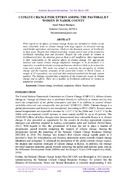| dc.description.abstract | With regards to the effects of climate change, Kenya has identified its ASALs as the most vulnerable areas to climate change with huge impacts on livestock rearing, small-holder agriculture and tourism, which are the dominant sources of livelihoods in these areas. Despite their limited ownership, women control most of the productive livelihoods including land and livestock. Despite the role played by women in livelihood activities, the attention given to them is still insufficient. More importantly is their vulnerability to the adverse effects of climate change. For appropriate national and county climate change adaptation strategies to be formulated, it is imperative to establish already existing mechanisms which are likely to form basis for some entry points. This study was aimed at assessing the perception of climate change and the response strategies of the pastoralist women in Narok County. A sample of 51 respondents was used and data analyzed qualitatively through content analysis. The findings revealed that a majority of the women are aware of climate change and its effects. There are a number of livelihoods embraced by women as adaptation strategies. | en_US |
